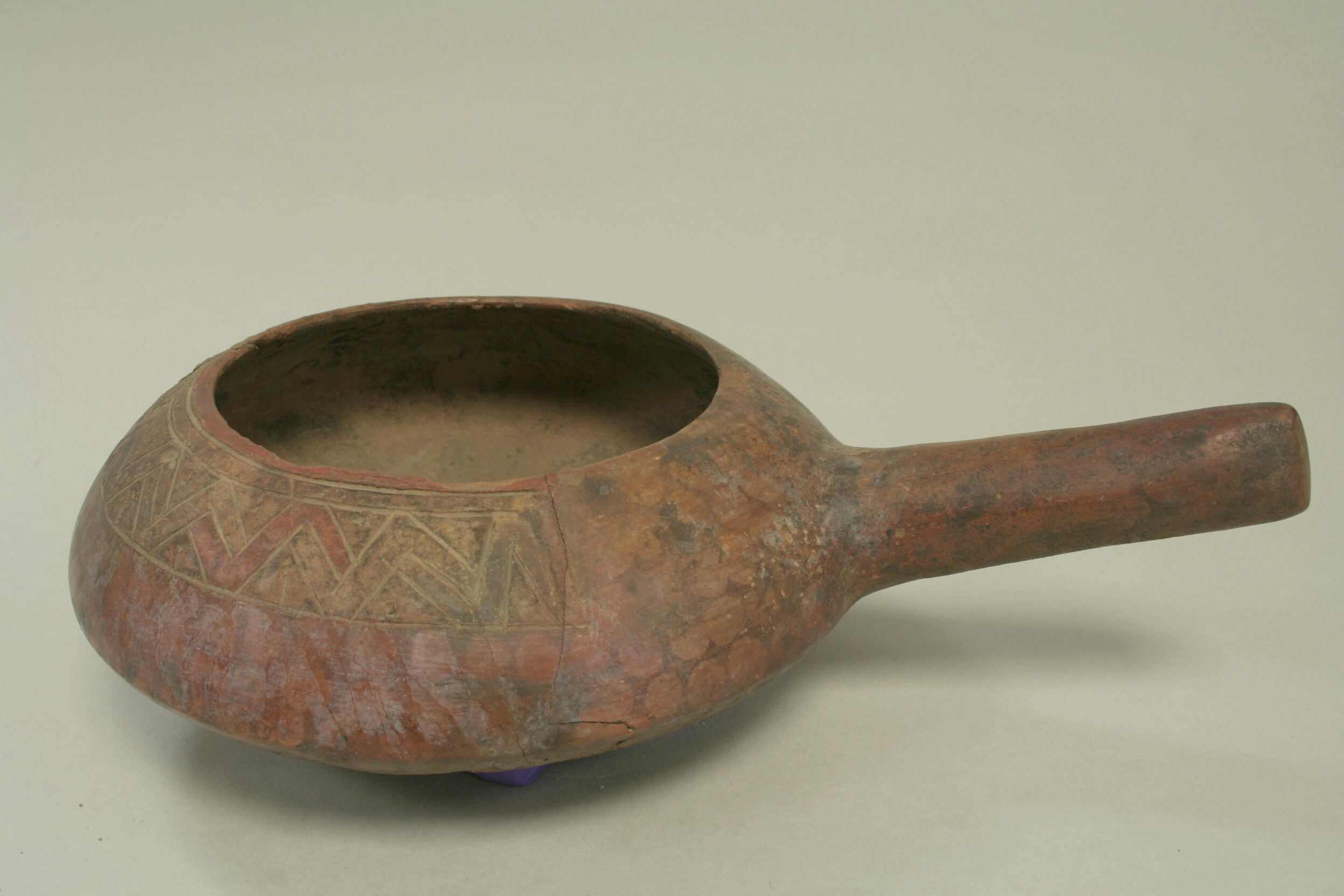Vessel with Handle
Not on view
This vessel with a handle is from the Paracas culture of the south coast of Peru (5th – 2nd centuries B.C.) has a round body with long handle. It contains decorative elements created using two different techniques. The first is a band of geometric design along part of the mouth of the vessel, defined by making incisions prior to firing, then applying colored paint after firing. This technique is called post-fire resin painting. The paint was made by mixing mineral pigments with plant resin to adhere to the surface of the ceramic. The bright colors often used with this technique are red, yellow, brown, black, and white. Scholars have suggested that the usage of certain pigments may indicate access to, and circulation of, the various resources needed in paint production which came from areas outside the Paracas region, which may be indicative of trade networks. Post-fired painting is a technique noted early in Paracas society.
The second surface decoration was created using a negative resist technique, evident in the pattern of lightly-colored dots that covers the middle and lower parts of the vessel body. Prior to firing the object in a kiln, the artisan applied a waxy substance to the areas of the vessel to prevent those areas from changing color during the firing process. The substance would then melt off, leaving the pattern, in this case the uneven dots, in its place. The use of negative resist technique is thought to occur later in Paracas society. Other examples of this vessel form are found in the MMA collection, such as this vessel, 64.228.116 , however the use of two technological methods, negative resist and post-fired painting is more uncommon.
This vessel was likely discovered in a funerary context. The Paracas culture is well-known for their practice of interring their dead as “mummy bundles”. The practice of making mummy bundles involved the interred individual seated in a basket and wrapped and buried in multiple layers of rich textiles, with adornments such as jewelry, food, ceramic vessels, and more. The textiles that have come from this burial tradition are exceptionally well-made in both the fineness of their construction and the bright, complex patterns that adorn them. Many of these burial items could have been used in daily life, but in ancient cultures, including Paracas continued veneration of the dead was important and it is likely that such burial items were an important part of funerary rites and Paracas conceptions of the afterlife.
Emily Field, M.A., Bard Graduate Center, 2017
References and Further Reading
DeLeonardis, Lisa. “Encoded Process, Embodied Meaning in Paracas Post-Fired Painted Ceramics,” Making Value, Making Meaning: Techné in the Pre-Columbian World, edited by Cathy Costin, pp. 129-166. Washington D.C.: Dumbarton Oaks Research Library and Collections, 2016.
DeLeonardis, Lisa. “Interpreting the Paracas Body and its value in Ancient Peru.” In The Construction of Value in the Ancient World, edited by John K. Papadopoulos and Gary Urton, pp. 197-217. Los Angeles: Cotsen Institute of Archaeology, University of California, Los Angeles, 2012.
Knudson, Kelly J., Ann H. Peters, Elsa Tomasto Cagigao. Paleodiet in the Paracas Necropolis of Wari Kayan: carbon and nitrogen isotope analysis of keratin samples from the south coast of Peru. Journal of Archaeological Science 55(2015): 231-243.
Paul, Anne. “Paracas Necropolis Bundle 89: A Description and Discussion of its Contents” in Paracas Art and Architecture: Object and Context in South Coastal Peru, edited by Anne Paul, pp. 154-189. Iowa City: University of Iowa Press, 1991.
Peters, Ann. Funerary Regalia and Institutions of Leadership in Paracas and Topara. Chungara, Revista de Antropolgia Chilena 32 no. 2 (2000): 245-252.
Proulx, Donald A. “Paracas and Nasca: Regional Cultures on the South Coast of Peru” in Handbook of South American Archaeology, edited by Helaine Silverman and William Isbell, pp. 563-584. Springer, 2008.
Sawyer, Alan and Nathan Cummings. Ancient Peruvian Ceramics: The Nathan Cummings Collection. New York: The Metropolitan Museum of Art, 1966.
Silverman, Helaine. Ancient Peruvian Art: An Annotated Bibliography. Reference Publications in Art History, New York: G.K. Hall & Co., 1996.
Vreeland, James M. "Mummies of Peru" in Mummies, disease & ancient cultures, edited by Aida Cockburn, Eve Cockburn and Theodore A. Reyman, pp. 154-189. Cambridge: Cambridge University Press, 1998.
Due to rights restrictions, this image cannot be enlarged, viewed at full screen, or downloaded.
This artwork is meant to be viewed from right to left. Scroll left to view more.




